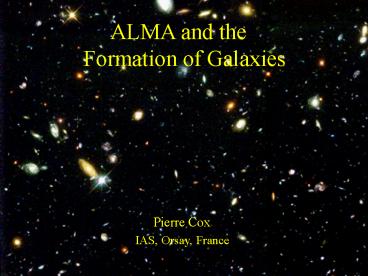Galaxy Formation and Evolution - PowerPoint PPT Presentation
Title:
Galaxy Formation and Evolution
Description:
Galaxy Formation and Evolution – PowerPoint PPT presentation
Number of Views:64
Avg rating:3.0/5.0
Title: Galaxy Formation and Evolution
1
ALMA and the Formation of Galaxies
Pierre Cox IAS, Orsay, France
2
The stellar systems are scattered through space
as far as telescopes can penetrate. We find them
smaller and fainter, in constantly increasing
numbers, and we know that we are reaching out
into space, until, with the faintest nebulae
than can be detected with greatest telescopes,
we arrive at the frontiers of the
known Universe. Edwin Hubble, The Realm of
the Nebulae (1936)
3
A Galaxy is a large Assemblage of Stars, Gas and
Dust that is held together by the mutual
gravitational interaction between its
Constituents. Galaxies contain between a few
million and about ten trillion Stars together
with differing proportions of interstellar matter
(Gas Dust)
Spiral Galaxy NGC1512
4
(No Transcript)
5
A Galaxythe Tip of the Iceberg of Dark Matter
Angular Momentum of the Halo
Dark Matter Halo
M1012 Msol
Hot Gas
Old Stars
Young Stars
Cold Gas
Supernova
100 kpc
6
8
Age of the Universe
Redshift
Z1000
Hierarchical Formation
Z 10
Today
7
HOW WERE THE GALAXIES FORMED ?
8
COBE
The Early Universe
Boomerang
The last scattering surface of the cosmic
microwave background reveals information on very
low amplitude density variations in the dark
matter 300,000 years after the Big Bang, and on
the origin of these fluctuations within the first
10-35 sec.
9
Simulations of the Developments of Large Scale
Structures in the Universe Dark Matter
and Gas Dynamics
10
The Distribution of (invisible) Dark Matter can
be mapped using the (Gravitational Lens)
Distortion of the Images of Background Galaxies
Background Galaxies
Foreground Cluster Abell 2218
11
Galaxy Evolution
Galaxies at zgt 2 are multiple with evidence of
merging
Assembly of large Galaxies was evidently
completed at zlt1
12
(No Transcript)
13
Visible (baryonic) Matter is at the Center of the
Gravitational Wells
14
The merging of two Galaxies
15
Stephans Quintet
16
The Center of the Milky Way
The Effect of Dust
17
UV
18
Infrared/submm Spectrum of Galaxies Dust Gas
Dust Graphite, Silicates..
Gas Atomic (H, C, O, N.) Molecular (CO, HCO)
19
M83
Optical
Carbon Monoxide CO(1-0)
SEST
20
The Antennae Galaxy
HST Optical image CO
HST Optical image
21
Optical is not the whole story
Population of rare but high luminosity sources
(1012 Lsun) matches energy output of UV-selected
population at high z
22
Cluster A1835
0.7ltZlt2.5
Z2.55
23
Dust and CO in BR1202-0725 at z4.7
24
- a mm/submm equivalent of VLT, HST, NGST with
corresponding high - sensitivity and angular resolution but
unhindered by dust opacity - a capability to see star-forming galaxies out to
the highest redshifts
25
Surveys of high redshift galaxies with
ALMA mm/submm sensitive searches to obscured,
star-forming regions TODAY about 200 sources
known ALMA many 100,000 sources
ALMA will detect objects to redshifts as high as
10-20
Into the Reionization Epoch
Morphology, Physical Chemical Properties
26
High Angular Resolution Sensitivity
27
Gravitational Lensing by a Cluster of Galaxies
Submillimeter
Optical
28
ALMA will revolutionize our understanding of the
Formation of Galaxies in the early Universe
- mm/submm is a vital new window on the distant
Universe - unobscured view of star-forming galaxies, at
wavelengths containing most of the luminosity of
the distant Universe - ALMAs sensitivity and angular resolution are
essential to realize this potential - ALMAs scientific contributions will include
studies of the earliest galaxies, an accounting
of the bolometric luminosity of the distant
Universe, and the evolution of galaxies, quasars
and the elements over cosmic time
29
We are, by definition, in the very center of
the observable region. We know our immediate
neighborhood rather intimately. With increasing
distance, our knowledge fades, and fades rapidly.
Eventually, we reach the dim boundary, the
utmost limits of our Telescopes. There, we
measure shadows, and we search among ghostly
errors of measurement for landmarks that are
scarcely more substantial. The search will
continue. Not until the empirical resources
are exhausted, need we pass on the dreamy realms
of speculation. Edwin Hubble, The Realm of
Nebulae (1936)






























